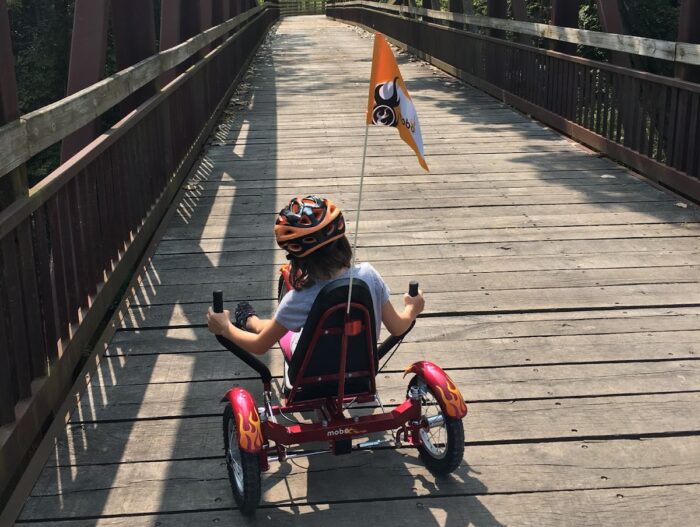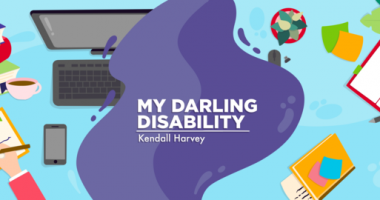Learning and listening: Talking to your child about Friedreich’s ataxia

Elizabeth Hamilton’s daughter, Amelia, rides her trike across a bridge. (Photo courtesy of Elizabeth Hamilton)
The journey of three and a half years, six genetics doctors in five cities, and three different states ended with a phone call in a parking lot at 6 p.m. on a Friday. The voice of the genetics counselor came with an apology and the name Friedreich’s ataxia (FA).
Our daughter Amelia’s body had been through so much testing and so many declines. When we finally had the answer, it arrived with relief, fear, and the determination summoned from a child’s well-being on the line. We had bridged the place of unknown to the known.
There is power in knowing names. Up until then, we called it wobbly legs, a phrase coined by our 8-year-old. With this name, Friedreich’s ataxia, we were able to find our research organization (Friedreich’s Ataxia Research Alliance, or FARA), a parent community (FA Parents’ Group), and a story of two men with FA who biked across the United States. It was here that we began the conversation with Amelia.
 Find an FA specialist near you
Find an FA specialist near you
Our explanation to her of FA was not as impactful as her connection to a greater community. A quiet child, Amelia often played alone at recess, unable to keep up. It was a source of many tears and a sense of isolation.
I held her in my lap, showed her a picture of Kyle Bryant, an athlete and FARA spokesperson, and said, “Baby, he has wobbly legs too — just like you.” In that moment, the light that sparked in her eyes and the small smile on her face was burned into my heart. She was not alone; we were not alone.
The messaging about this diagnosis has changed as Amelia has embraced rideATAXIA, a nationwide bike event founded by Bryant; met more role models with FA; and engaged in studies and clinical trials.
I still find myself in new situations and unsure of next steps. Luckily, when I am stuck, I have other FA parents to turn to or other parents of children with rare diseases in my corner.
One set of parents have a son with FA in his late 20s. As we looked forward with Amelia into the unknown, they looked back with the wisdom of experience. I have since reached out to Glen and Barbara Bianchi to collect advice. Their insight usually hits home, and I am privileged to share it.
Relationships matter, and it is incredibly important to bring relationships into your child(ren)’s journey with FA. Cultivating a relationship for our kids with someone who can be a role model is valuable any day. And if that person happens to have a disability and they are living a positive, constructive life, that’s particularly influential. Showing our children others who are navigating an FA diagnosis well can be invaluable to their sense of well-being. We are more likely to be what we can see.
It’s OK not to have the answers or to need assistance. While I was relieved to talk to Amelia about FA, the Bianchis leaned on their doctor to navigate that conversation with their son. Both options worked for our individual families.
Push purpose with your child as well as setting goals, having dreams, and facing challenges as they come. Discuss the diagnosis, but do not let the diagnosis define them.
Deal with the information you know now, not what could be down the road. The internet can be full of unhelpful information. Internet searches should be done with a parent or caregiver present.
Talk with your child about what will be important as they navigate this disease. Be active, engage in strong nutritional choices, and lean into what you can do, not what you cannot.
Support from our FA community and the Bianchis has helped me stay grounded. The goal is not to be perfect, but to help our children move over the gap from what they know now, to what we need them to know to be the best version of themselves.
Here are some of my tips when bridging that gap:
Be present. Be with your child as you are. Shut down devices and distractions, set aside unrealistic expectations of yourself, and be present. You are enough.
Regulate yourself and your child before you begin the conversation about the FA diagnosis. The best exchanges and connections happen when we are calm. Tips to help would include taking your child for a car ride, having a beloved pet nearby, going for a walk or a stroll if they are in a wheelchair. Notice your breath: Is it shallow, are you nervous? You set the tone and your child is watching you. Breathe and rest when you can.
Individualize the message. You know your child; tailor the conversation to meet their needs. Think about what they find triggering, what they would find comforting — and make sure it is developmentally appropriate. A good way to think about child development is with Erikson’s eight stages of development, which describes how challenges at each life stage influence the progression and growth of the individual throughout their life.
Discuss what is relevant now. Do not dwell on the “what if” but live in the now.
Give your child space to ask questions and accept that those questions might come when least expected. It is OK to tell your child that you do not know but will work to get them an answer or that you will think about it.
Empower your child and your family. How do you teach your child to advocate for themselves and provide space for them to take a lead role in the process? What can you do on this journey? Will it be fundraising or building awareness? Will it be engaging in a study or a clinical trial? Maybe you will find yourself writing columns about your journey. You have a part to play in our disease community and we need you.
Every diagnostic odyssey is unique. Our story and path are our own. It does not make them less or more; it just makes them ours. When things change, we surround ourselves with the strength of our community, we dig deep, pull on the wisdom I know you carry, and we recalibrate. Here’s to the journey, every step, every path, and every bridge. Let’s travel together.
Many thanks to Glen and Barbara Bianchi for sharing themselves.
Friedreich’s Ataxia News is strictly a news and information website about the disease. It does not provide medical advice, diagnosis, or treatment. This content is not intended to be a substitute for professional medical advice, diagnosis, or treatment. Always seek the advice of your physician or other qualified health provider with any questions you may have regarding a medical condition. Never disregard professional medical advice or delay in seeking it because of something you have read on this website.
About the Author

Ohio native Elizabeth Hamilton felt her world flip when her younger daughter’s health unexpectedly declined. It took six hospitals in five different cities and three states to obtain the diagnosis of Friedreich’s ataxia in 2020. A licensed social worker, Elizabeth believes that relationships are a healing force, and most problems can be solved if you have the right tools and the right people. Life takes unexpected turns, so we must take a moment to reexamine where we are and recalibrate.
Recent Posts
Related Articles





